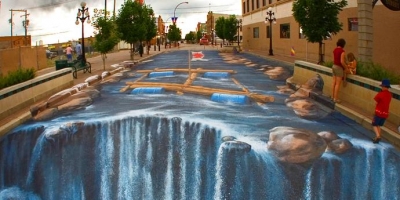
When it comes to art, what you see is not always what you get. An art technique known as trompe l’oeil uses realistic imagery to create an optical illusion that the depicted objects exist in three dimensions.
Trompe l’oeil was widely popular during the Renaissance, the technique was often employed to murals and frescoes on church ceilings. The fresco painting on the ceiling of the Church of Saint Ignazio in Rome, created by Andrea Pozzo during 1691-1694, is one classic example. A semi-circular roof is transformed into a fantastic picture of the heavens, in which Saint Ignatius ascends into paradise.
The term trompe l’oeil (meaning trick of the eye in French) was first used by artist Louis-Leopold Boilly as a title of his painting in Paris in 1800. It later gained currency throughout Europe. The technique was usually used to create the impression of a bigger space.
Artists Vittorio Carpaccio and Jacopo de Barbari took the technique further. They added small trompe l’oeil details to their paintings such as a curtain that appears to partly conceal the painting, or a person might appear to be climbing out of the painting altogether.
Putting things in perspective
A lesser-known art technique known as anamorphosis, is an offshoot of the trompe l’oeil technique. In anamorphosis, a deformed image appears in its true shape when viewed in an unconventional way. There are two types of anamorphosis images:
** Oblique – These images need to be viewed from a position that is very far from the usual positions from where we normally expect images to be looked at
** Catoptric – The image must be seen reflected in a distorting mirror. The Hungarian artist István Orosz has produced some beautiful examples of these
How does it work?
We tend to believe something is real if we see it in front of us. However, seeing is not a direct perception of reality. What we see is the result of our brains constantly interpreting and giving structure to the raw visual input from our eyes. Artists use this knowledge to create optical illusions in the tromp l’oeil paintings.
Picture Credit : Google

